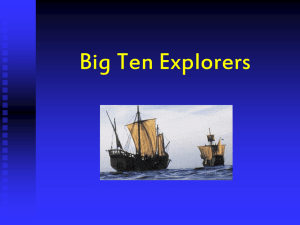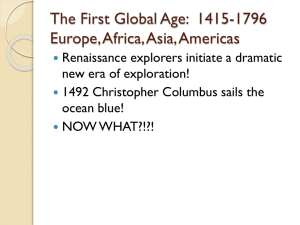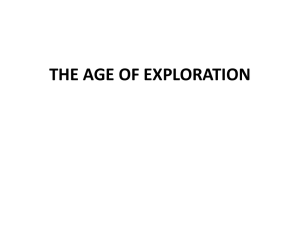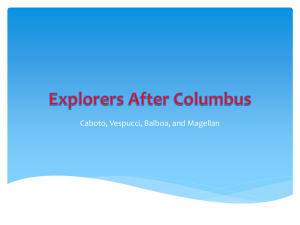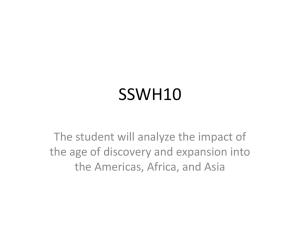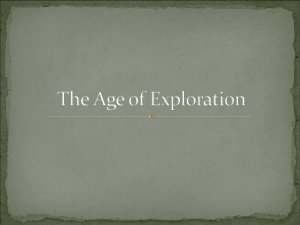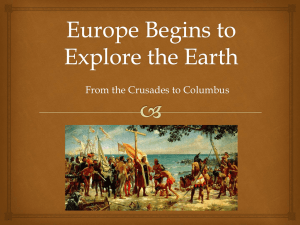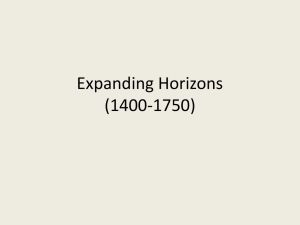Chapter 16
advertisement
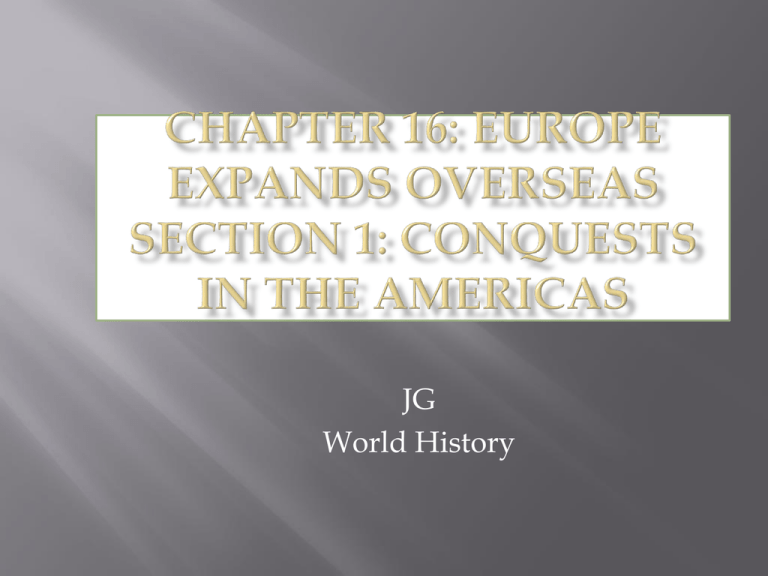
JG World History Europeans had been looking for a better, faster way to reach areas filled with riches in Asia. A Route West Italian navigator Christopher Columbus was a skilled sailor and expedition organizer. He wanted to discover new routes to the riches of Asia. Columbus thought he would reach Asia if he sailed west across the Atlantic Ocean. He convinced King Ferdinand and Queen Isabella of Spain to finance, or pay for, his voyage. The First Journey Columbus's fleet set sail from Spain on August 3, 1492. The fleet stopped in the Canary Islands, off the northwest coast of Africa, for repairs and fresh supplies before setting off again on September 6. Life on board ship was hard, and the work seemed endless. A. The First Journey There were about 90 crew members altogether who sailed on the expedition. Cooking was done on deck with portable woodburning stoves. water that washed into the ship had to be pumped out. A few officers had bunks, but everyone else slept on deck in good weather or below deck during storms. Finding New Lands On October 12, the crew spotted land in the group of islands in the Caribbean Sea presently called the West Indies. Columbus thought he landed in the East Indies, a group of islnds near the mainland of East Asia. Columbus named the island on which they landed San Salvador. He described the islanders, called the Taino, as gentle and primitive. Finding New Lands Columbus took several captured islanders with him back to Spain. A grand reception given by King Ferdinand and Queen Isabella awaited Columbus when he arrived in Spain with some gold trinkets and the few Taino people who had survived the voyage. Impact Of Columbus's Voyage Columbus search for a new sea route to Asia led to contact between Europe and the Americas. This contact triggered many changes in the cultures of both worlds. Explorers mapped parts of the coastlines of North and South America and claimed and colonized parts of the interiors of both continents. Impact Of Columbus's Voyage The arrival of the Europeans was devastating to the indigenous, or native, populations of the Americas. When Columbus first arrived in the Caribbean, more than 40 million native Americans lived in the Americas. About 80 years later, their numbers had decreased to about 3 to 4 million. Impact Of Columbus's Voyage While many died from overwork and abuse, illnesses, such as measles, smallpox, and tetanus, killed most of the native population. The illnesses had been brought over from Europe by the crews of the ships. The indigenous populations had no natural defenses against these illnesses. Cabral Sails For Portugal In 1500, Pedro Alvarez Cabral, representing Portugal, sailed southwest across the Atlantic Ocean. On April 22, he sighted land, which he called Island of the True Cross. This newly claimed possession of Portugal became a stopping-off point for later long voyages from Europe to India. Ships would sail southwest to the Island of the True Cross, and then head Southeast to Africa’s Cape of Good Hope. America’s Namesake Amerigo Vespucci, an Italian navigator, made at least two voyages to the Americas between 1499 and 1502. During the first Spanish-financed expedition, Vespucci reached the northern coast of South America near what is now Guyana. Vespucci’s second expedition was financed by Portugal. Vespucci reached the coast of Brazil and continued southward, possibly as far as Patagonia in present-day Argentina. America’s Namesake Vespucci’s second voyage was important because he and others were convinced that the newly explored lands were not Asia, but some sort of a “new world.” In 1507, a German mapmaker who had read of Vespucci’s expeditions called this new land America in Vespucci’s honor. Discovery of the Pacific Vasco Nunez de Balboa joined a Spanish expedition in 1501. He explored the northern coast of South America, settled on the island of Hispaniola for a time, and led expeditions into Panama. In 1513, Balboa followed trails across the Isthmus of Panama. After three weeks of walking, his native guides told him that a great sea could be seen if he climbed a nearby mountain. C. Around the World Ferdinand Magellan was a Portuguese navigator and explorer who first sailed for Portugal and later for Spain. When he offered his services to King Charles I of Spain, Magellan proposed to sail west across the Atlantic. He hoped to find a strait-a narrow waterway-through the landmass of the Americas to the Pacific Ocean. C. Around the World Magellan had a practical reason for his proposal. He wanted to prove that the Spice Islands, or the Molucca Islands in present-day Indonesia, were located west of the line established by the Treaty of Tordesillas. The Spice Islands were then controlled by the Portuguese, and Portugal earned great wealth from the sale of spices. Magellan’s Journey Magellan set off from Spain on September 20, 1519, with 5 ships and a crew of about 250 men. Magellan sailed south along the African coast. He crossed the Atlantic at the ocean’s narrowest point, instead of talking the usual route west from the Canary Islands. On October 21, 1520, the fleet entered the eastern end of a dangerous 350-mile strait, located near the southern tip of South America. C. Around the World When the fleet emerged on the western end of the strait, they found themselves in a new body of water. Magellan named this body of water the Pacific Ocean because of its relatively calm waters. This body of water is the same one that Balboa had called the South Sea. During the next four months, Magellan and his fleet sailed westward across the Pacific Ocean, hoping to find Asia. The Growth of Mercantilism As A pArt of MegellAn’s voyAge, sAilors had for the first time circumnavigated, or sailed around, the world. This achievement, which started with the belief of Christopher Columbus that a ship could sail west across the Atlantic to reach Asia, was accomplished when the last ship of MAgellAn’s fleet liMped into port. A. Spain's Vast Empire During the 1500s, Spain acquired the world’s largest overseas land overseas land holdings as Spanish explorers colonized the Americas. Cortes Invades Mexico In February 1519, the Spanish conquistador Hernan Cortes set out for the Yucatan coast, in present-day Mexico, with 11 ships, 508 soldiers, 100 sailors, and 16 horses. When he arrived, Cortes formed alliances with local peoples, gathering information about a nearby civilization-the Aztecs. Cortes Invades Mexico Over the next several months, Cortes worked his way to the Mexican interior. Along the way, Cortes made connections with various indigenous groups. Cortes used to his advantage the bitter resentment felt by many groups that were forced to pay tribute to the Aztecs. More than 200,000 Native Americans became his allies. Moctezuma’s Fall many Aztec people, including their emperor Moctezuma, believed in a legend about a bearded god called Quetzalcoatl, whom they feared and expected would return to rule someday. Moctezuma, thinking Cortes might be the god Quetzalcoatl, tried unsuccessfully to keep Cortes away from the Aztec capital of Tenochtitlan. Pizarro and the Incas In 1531, Francisco Pissarro set off with a small expedition of 180 men and 37 horses to the Inca Empire in present-day Peru. The Incan emperor, Atahualpa, agreed to meet with Pizarro. Atahualpa offered a huge ransom of pure gold for his release, which Pizarro accepted before having the emperor put to death. When Incan heard of their larders death, they retreated. Pizarro took the royal capital of Cuzco without a struggle ion 1533. Government and the Economy In 1524, the Spanish monarchy created the council of the indies, a lawmaking body for their new possessions. Viceroys, representatives of the monarch, were the principal governors of the American colonies, which were divided into providences. The viceroys were chosen from among Spanish noble families and where required to report to the council of the Indies in Spain. The Columbian Exchange Ferdinand and Isabella hoped to use the wealth of this new land to their advantage. In addition, Columbus had brought back plants and animals from the Americans that were unknown In Europe. The impact of the Columbian exchange The Columbian exchange, tobacco and cocoa became popular in Europe. People in the Americans were also exposed to European foods, animals, and ideas. Cotton was introduced in the America. Sugar cane, brought to the West Indies, became the main cash crop of the region. From Europe also came the horse, a new mode of transportation, and cattle, a new protein source. The Role of Missionaries As Spain and the rest of Europe benefited from the new products and ideas obtained through the Columbian Exchange, Spain’s Christian missionaries hoped to gain other things from the Americas. Bartolone de las Casas was a Spanish missionary who was granted an encomienda in 1513. Colonial Cities Most Spanish settlers in the Americas preferred to live in cities. Cities were established throughout the colonies and grew quickly. To the Spaniards, colonial cities were centers of government, religious life, culture, and trade. Spanish cities had the same design—a central square bordered by a church, a government building, and a house for the viceroy, or governor. Colonial Culture Colonial culture was a mixture of Spanish, Native American, and African traditions. Although Spanish culture was dominant in all of Spain’s colonies, its mixture with different traditions led to the formation of a unique blended culture in Spanish America. As in most societies, different classes provided a framework for colonial social structure. Creoles, American-born descendants of Peninsulares, occupied the next highest level of society. Portugal’s Expansion in Brazil As more and more Portuguese people were encouraged to move to Brazil to establish permanent cities and farms in the 1500s, the colony slowly but steadily grew. By 1600, some farming regions had twice as many enslaved Africans and Native Americans—most of whom worked as field laborers—as colonist’s. Chapter 16: Europe Expands Overseas Section 3: Dutch, French, and English Colonies Portuguese Society and Culture As in Spanish America, Portuguese culture in Brazil was a mix of European, Native American, and African traditions. European culture dominated class and race divisions in Brazilian society as it did in Spain’s colonies. Dutch Interest In the early 1600s, the Dutch—people who lived in the Netherlands—became Europe’s strongest naval power. They held this position until the late 1600s. They acquired much of Portugal’s eastern trading empire and seized part of Brazil after an invasion beginning in 1624. The Dutch in North America In 1609, Henry Hudson, an English explorer hired by the Dutch to find a water route through North America to Asia, sailed up a river in present-day New York State. Today this river is know The Dutch in North America In 1609, Henry Hudson, an English explorer hired by the Dutch to find a water route through North America to Asia, sailed up a river in present-day new York State. By 1624, the Dutch had established a colony and had named the area New Netherlands. Colonizing New France New France became a province in 1663. French troops arrived two years later to protect settlers against the Iroquois—the Native Americans of that region. The French government had trouble attracting settlers to New France. The long winters and attacks by the Native Americans in the area discourage many farmers. French West Indies Settlements in the Caribbean began in 1625. Four decade later, France possessed 14 Caribbean islands . Guadeloupe and Martinique were its main holdings. Slaves were imported from Africa as early as 1642 to work the large plantations, where sugar was the main crop. Early English Colonies Founded in 1607, Jamestown, Virginia, was the site of the first successful English colony in North America. England's King James I issued a character, or official document, to the Virginia company allowing it to send settlers to the Atlantic coast of North America. Thirteen Colonies Thirteen English Colonies were established in North America during the 1600s and 1700s. All thirteen colonies were agricultural, but geographic conditions fostered different ways of life. In the New England colonies, those farthest north, farming was difficult due to poor soil and harsh winters. In the Middle of the eastern coaster region, farms were larger and more diversified because of a milder climate and more fertile soil. Sharing Land The European nation followed different policies toward native North Americans, according to each country’s aims. The main interest of the Dutch was to establish trade markets and networks. They were very tolerant of others, and they did not have a strong interest in converting Native Americans to their religion— Protestantism. After its defeat at New Netherland in 1664, the Dutch colony became English. King Philip’s War With time more colonists arrived, the demand for land grew. The colonies spread west, taking more and more land from Native Americans. When Massasoit died, his son Met comet, known as King Philip, became chief of the Wampanoag's. Met comet wanted to stop the colonists from expanding into new areas. In 1675, Native Americans raided frontier settlements along the Connecticut River and in the Massachusetts Colony. Rising Prices Higher prices led Spaniards to buy cheaper goods from other countries. The silver and gold left Spain when Spaniards purchased these cheaper foreign goods. As increased amounts of Spanish gold and silver arrived in other countries, prices for goods rose quickly in those countries as well. Overseas Investments The overseas trades well expansion of European empires in the Americas led to the growth of capitalism, the investment of money for profit.
